Students Experience Interdisciplinary Animal Research Via Alma’s Talking Dogs RSO
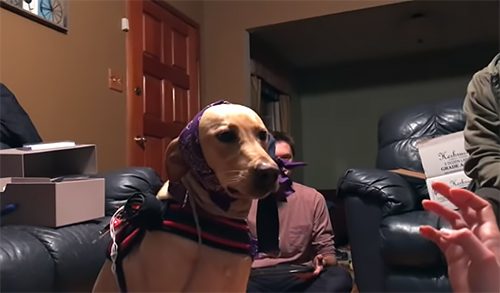
Alma sits through an EEG. (Image courtesy of Bliss Chapman's YouTube video: Alma the Talking Dog - Dug the Dog IRL).
October 27, 2020
No, Alma’s Talking Dogs is not a circus act. It's actually an EOH exhibit, turned animal research project, turned RSO—probably the most uniquely named RSO on campus. But for Illinois students who are passionate about interdisciplinary research, it fills the bill, not only providing an opportunity to conduct research, but to collaborate with like-minded students across a variety of disciplines, as well as do public engagement. Plus, it enables members to get their periodic doggie fix.
Back in 2018, Alma's Talking Dogs began as a project for Engineering Open House (EOH). Focused on a student’s dog (named Alma), the project was comprised of six students, including Suva Narayan, a Bioengineering student who’s currently the treasurer of the RSO but who was a freshman back then. About a year later, in 2019, spearheaded by Amanda Maher and several others, including Narayan (now the only remaining member of the original team), they decided to start up an RSO (Registered Student Organization). Thus, the Alma’s Talking Dogs RSO was born. With an original membership of around 11 or so, it’s doubled in size, and currently has around 22 members from many different majors.
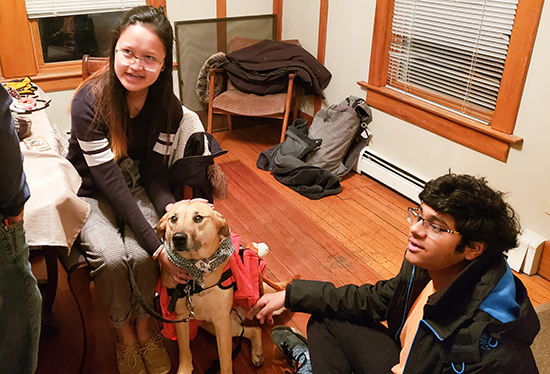
Lauren Gil and Suva Narayan pet Penny as she waits for EEG testing. (Image courtesy of Joseph Sim.)
“But they all have a sense of wanting to contribute, which is really nice,” explains Lauren Gil, a senior in Animal Sciences and currently the president of the RSO. “And some of them don't really have as much experience as others, so we really like to emphasize we enjoy having learners and working together in an interdisciplinary setting.”
In addition to the president and treasurer, the RSO’s other officers include a secretary as well as a chief engineer, who manages the various teams: the Animal Interactions, Mechanical, Software, and Electrical teams.
Gil indicates that one of the challenges in 2020 has been holding meetings of the constituency yet abiding by COVID-19 social distancing restrictions. Thus, having whole-group, in person meetings, which would enable everyone to get to know each other didn't really work out. So, all the sub teams meet individually, once a week via Zoom, then they all come together for about 15–30 minutes.
The name Alma’s Talking Dogs pretty aptly describes what the RSO is all about. For instance, Alma refers to their original dog test subject—Alma, a golden retriever. Of course, as with most RSOs, seniors graduate. Thus, the RSO’s namesake, Alma the dog, moved on when her owner, Christie, graduated, taking her dog with her. So now, the new part mascot, part research subject of the RSO is Penny from Hospice Hearts Animal Rescue, an all-volunteer, foster-based animal rescue in Central Illinois that serves cats and dogs.
The last part of the name, “Talking Dogs,” refers to the group’s main focus, which is interdisciplinary research—performing an EEG (electroencephalogram) to interpret their subject’s brainwaves. To gather the data, they use homemade, 3D-printed electrodes connected to wires that electrically transmit signals.
“Of course, it's not invasive,” Lauren says. “It's comfortable. We try to design the project so that she (their dog test subject) doesn't feel any stress or discomfort.”
Their goal is to interpret what kind of brainwaves they're reading, and then see where it spikes to indicate the electrical activity of the brain.
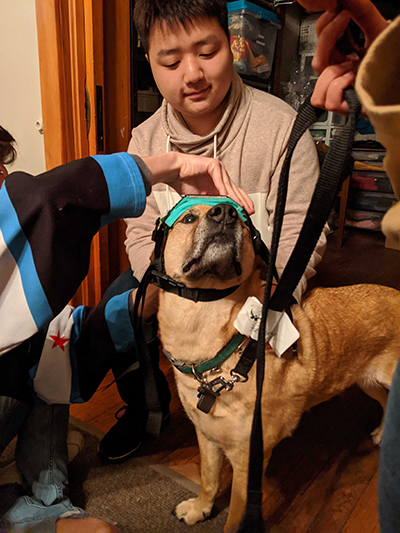
Joseph Sim, the current Mechanical Team Lead, with Penny. (Image courtesy of Lauren Gil.)
Gil shares what visits with Penny are like. She and another animal science student who make up the Animal Interactions team, visit Penny frequently to make sure she's comfortable with them, in order to ensure that there’s no “external stimuli that we could possibly be doing to skew the data.” Regarding visits, she says they try to come before everyone else does. “So that way we could at least tire her out a little by playing with her or going on walks; hopefully that will kind of make her less excited to see the rest of the members and then also help with the data.”
So how do they make the dog “talk?” The wires connect to an analog circuit mounted on a harness on the dog’s back, which amplifies the signal. An Arduino reads the data, then a Raspberry Pi retrieves the data from the Arduino and performs machine learning classification. As part of the original EOH project, for example, when the machine learning algorithm classified Alma's neural response as "Treat," the Raspberry Pi then triggered a pre-recorded "Alma" voice which would play via a speaker, speaking for the dog, who would “say”: “Oh! Treat! Treat! Yes, I want the treat. I do so definitely want the treat. I would be very happy if I were to have the treat!”
In addition to research, another goal of the RSO is public engagement. Along with their relationship with Hospice Hearts, they hope to eventually do outreach in some local K–12 schools. Thus, they’ve been trying to get information about their group to elementary schools around Urbana-Champaign in hopes that, once COVID-19 is over, they can visit some schools and “get kids more excited about STEM-related activities,” says Gil. “Hopefully, our goal is also to branch out and show people that, basically, anything is possible if you put your mind to it.” Since they have thus far been unable to visit schools as originally intended, their faculty advisor, BioE Professor Jenny Amos, recommended that they might make videos to send to teachers—one outreach possibility they’re considering.
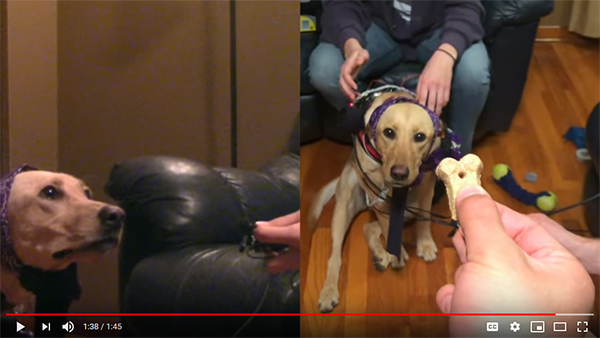
Alma receiving a treat during her EEG. (Image courtesy of Bliss Chapman's YouTube video: Alma the Talking Dog - Dug the Dog IRL.)
So how has being involved in Alma’s Talking Dogs impacted or benefitted its members? Gil says that what she enjoys the most is being able to communicate and grow together as a group with students who are interested in sharing with each other some of the knowledge and expertise they’ve gained in their discipline.
“I really do enjoy learning about what others are learning,” she explains… “It just kind of opens up a whole new world of things that I never was aware of before.”
For Narayan, his favorite part about the RSO is related to its interdisciplinary nature—being able to work with majors that are beyond his own major—BioE. For instance, the RSO’s membership is comprised of students from a variety of disciplines, including Bioengineering, Mechanical Engineering, Animal Science, and Computer Science. He reports:
“Just that interdisciplinary aspect of multiple majors coming together and working on the same problem, I guess, really opened my eyes to learning other aspects of what this could take.”
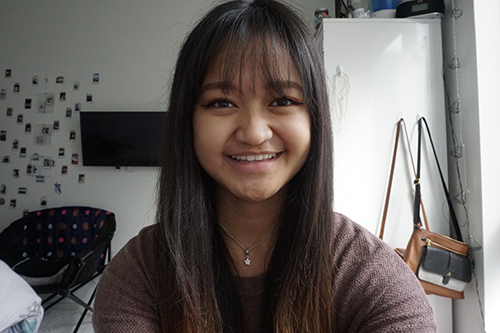
Lauren Gil, the current Alma's Talking Dogs president and a senior in Animal Sciences. (Inage courtesy of Lauren Gil.)
What other skills have the two gained via Alma’s Talking Dogs? According to Gil, being a part of the group has improved her communication skills. “So, for me personally,” she acknowledges, “I have difficulty trying to communicate and convey my ideas with other people. But this organization has really challenged me to kind of get out of my comfort zone and communicate with more people.” But beyond that, she claims, “It also helped me in a way where if I'm able to teach a concept or something to another person, then it also helps me understand what I know and what I don't. So, it also helps me with my academics.”
For the future, Gil envisions continuing to find like more ways on “how we can understand the behavior and the needs of dogs better.” Having recently talked with an Illinois alum who is a professor New Mexico, she reports, “He was really interested about doing augmented reality with dogs. And it was a really interesting conversation because I didn't realize that so much more technology could be built to basically enhance anything.”
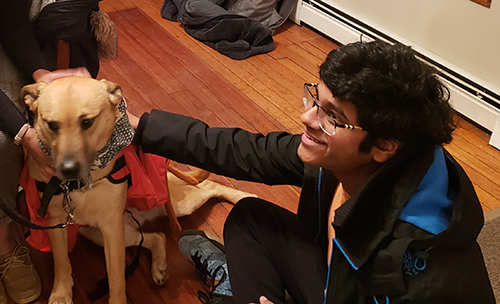
Suva Narayan (right) and Penny, as she waits to undergo testing. (Image courtesy of Joseph Sim.)
Narayan says the biggest way he’s grown is working collaboratively with other people— “being able to effectively communicate such that we get things done.” He refers once again to the RSO’s interdisciplinary collaboration, and “being able to work with different people of different backgrounds. He appreciates working with folks beyond his own major: “Being able to look at the same project, but from different aspects—what you're trying to do—really opened my eyes to being able to work collaboratively with all kinds of people.”
Narayan indicates that one area he’d like to delve into down the road is fundraising. Right now, they get most of their funding from Engineering Council, which helps other engineering RSOs find funding.
“So, one thing that we're thinking about is being able to set up fundraisers with other participating businesses in the area. That is a lot harder now due to COVID, but I'm working on it.”
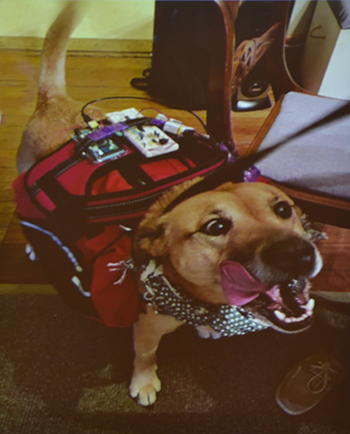
Penny during her EEG test. (Image taken from Powerpoint presentation given during SWE's Engineering exploration outreach.)
Regarding his goals for the RSO in the future, Narayan says: “I guess the main intent is being able to take the original project even further and possibly improve on the original prototype that we had.” Plus, he also hopes to branch out in terms of their research clientele. For example, he hopes to eventually be able to work with not just dogs, but also other animals, including maybe cats or birds.
Story by Elizabeth Innes, Communications Specialist, I-STEM Education Initiative.Photos by Elizabeth Innes unless noted otherwise.
More: Student Organizations, 2020
For YouTube videos about the original Alma the Talking Dog EOH project, please see:
- Alma the Talking Dog - Dug the Dog IRL: Bliss Chapman, 3/05/19
- Alma the Talking Dog - Trial footage: Bliss Chapman, 3/10/19
- Alma the Talking Dog - Test Trial: MechSE, 3/20/19
- Alma the Talking Dog: MechSE, 3/20/19
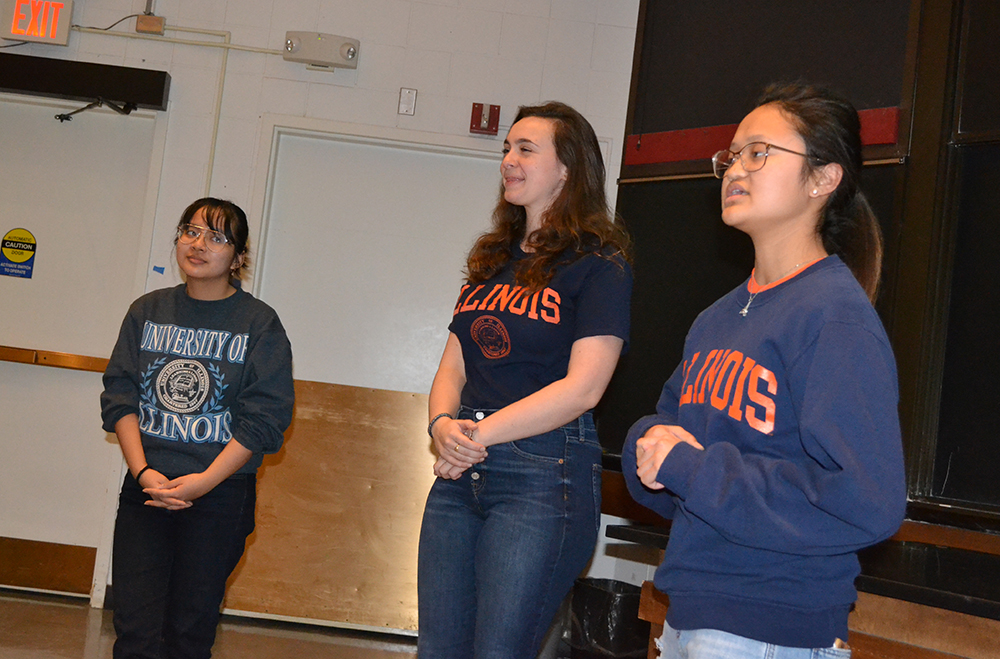
Kelsey Biscocho, Amanda Maher, and Lauren Gil give a presentation about Alma’s Talking Dogs during the Society of Women Engineer's Engineering Exploration outreach for 40 or so mostly middle school girls on February 22, 2020.
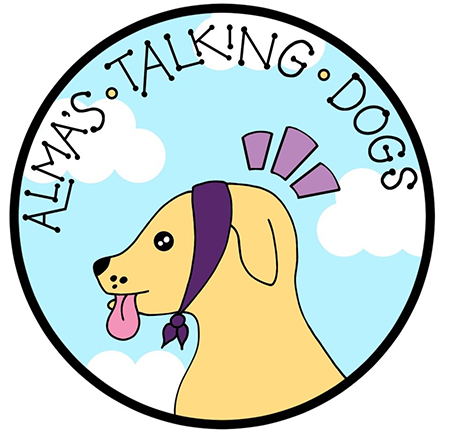













.jpg)
















